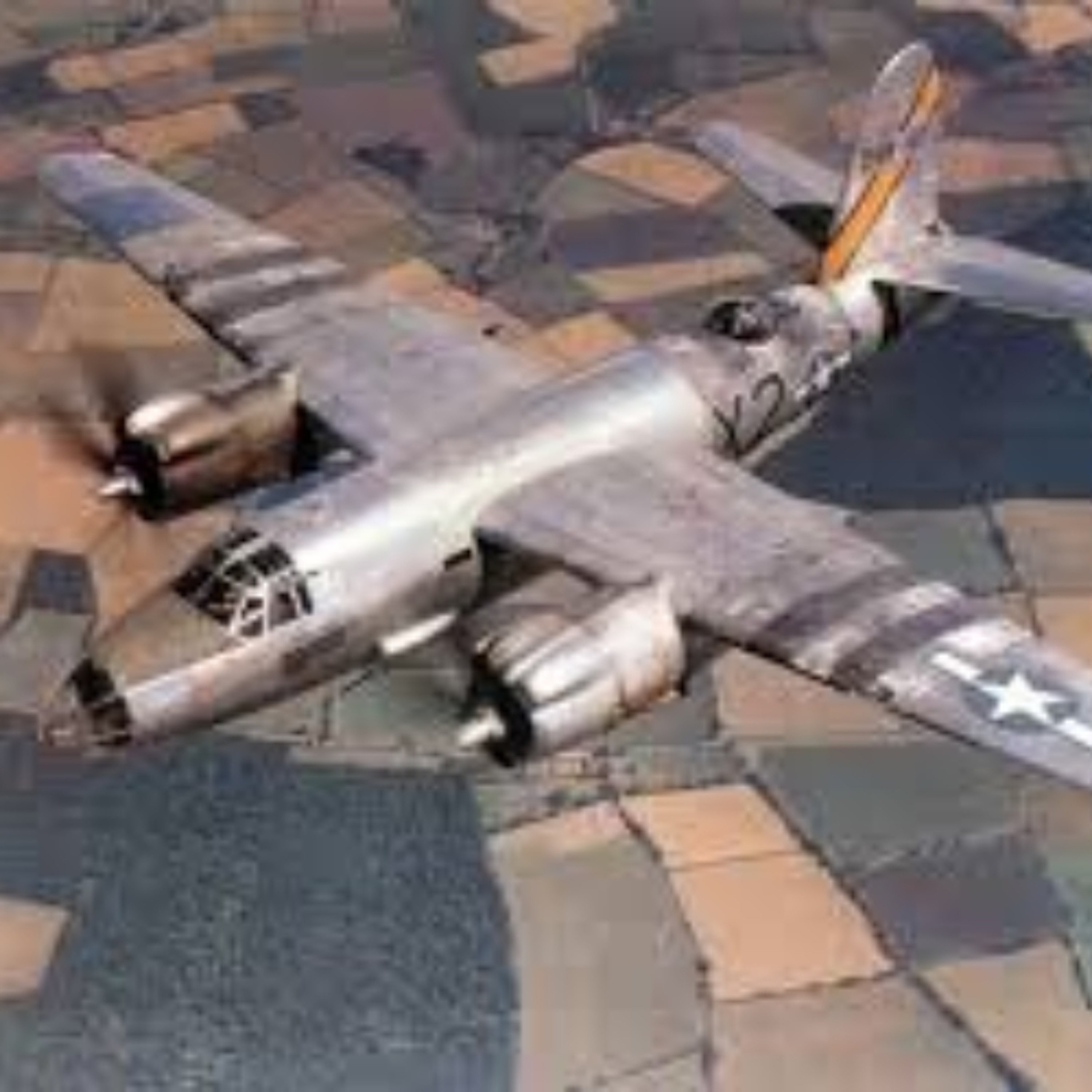*PREVIEW* The Raid on IJmuden
https://www.patreon.com/posts/131734686?pr=true
Press play and read along
Transcript
Speaker 1
If you ever wanted to catch us live, well, we're hitting the road again. We're returning to London on April 11th at 7 p.m.
at Rich Mix.
Speaker 1 Tickets are available now, and you can check the show notes for that link. There'll also be live stream tickets if you can't make it to London, so you can still watch us.
Speaker 1
And there'll be a separate link for that. So make sure you're getting the right tickets when you want to see us.
Our merch store is restocked.
Speaker 1 So if you missed any of the live show-specific merch at wherever date that we went to and you couldn't make it to, it's all on our merch store, llbdmerch.com. So get your orders in while they last.
Speaker 1
We only have certain sizes and certain numbers and whichever one it happens to be. So if you want something, get your order in.
Once again, that is llbdmerch.com.
Speaker 1
And the link will also be in the show notes. Thanks.
And we hope to see you in London.
Speaker 1
If you close your eyes and you picture a bomber in World War II, you're probably picturing the B-17 B-17 Flying Fortress. The U.S.
built over 12,000 of them.
Speaker 1 And that is not even the most produced heavy bomber of World War II. That goes to a different U.S.-produced bomber, the B-24, with nearly 20,000, which is just insane numbers.
Speaker 1
This is all during the war years specifically. It's a kind of industrial wartime muscle.
that the world had never seen before and quite possibly can never see again.
Speaker 1 Because even in the advent of some future horrible war, these kind of things just don't need to be built in this number, nor can they be due to technological advances.
Speaker 1 It's kind of like, dare I say it, airborne insertions, where like parachute insertions, like the technology, the skill set still exists, the technology, obviously they've adapted it to modern planes, modern airframes, but like the using planes to deploy troops quickly by parachute, like there's, it's just not the method of choice anymore because helicopters exist, among other things.
Speaker 1 And it's like for a huge number of people, sure, but like it's just not a thing that is used. It was like at the kind of bleeding edge in World War II, but things have changed.
Speaker 1 And similar, like what you've just described, I mean, for one, there's just, well, there's, there's one technology that makes, that can level an entire city without needing, you know, a fucking flying movie duck formation of bombers.
Speaker 1
It sucks, but it exists. And it didn't exist until the tail end of World War II.
Yeah.
Speaker 1 And what I'm getting at is so-called strategic bombing bombing was the cornerstone of American tactics during World War II, hence the use for all of those bombers.
Speaker 1 The goal of these bombing campaigns was obvious. They're supposed to target enemy infrastructure, military or civilian, because this is a total war we're talking about.
Speaker 1 Virtually nothing was off limits, because it is true that in a war like that one, any damage to a country is damage to warfighting capability. Does that make it moral, ethical, or even legal?
Speaker 1
Fuck no, but it does make it a tactic. With that said, let's move on to the meat of today's episode.
One of the bombers that the U.S.
Speaker 1 cranked out during the war and the job that it was given, that it was absolutely not suited for. The B-26 Marauder and so-called low-level tactical bombing.
Speaker 1
Now, just remember, this is tactical in the 40s. So the B-26 was interesting as a bomber.
for one pretty key reason.
Speaker 1 It was the first American bomber to be designed, produced, and fielded during the war. And as the heavy bomber role was already filled, this was determined to be a medium bomber.
Speaker 1 They answered to a lot of Army air commanders' questions about how do we cover the massive weaknesses in these heavy bombers?
Speaker 1 Because heavy bombers are slow moving, generally slow moving, lightly armed, easy planes to shoot down.
Speaker 1 Of course, they eventually filled a lot of these problems with fighter escorts, but that also requires more resources. So they wanted a bomber that could hypothetically work on its own.
Speaker 1 Yeah, you basically have to create the aviation equivalent of a cloud of bees because your primary weapon to deploy
Speaker 1 these bomber missions is basically a flying loaf of bread. And it's like, unfortunately, the flying loaf of bread is susceptible to bullets, among other things.
Speaker 1 A flying loaf of bread full of succulent, succulent early 20s flesh.
Speaker 1
Jesus Christ. I mean, you keep saying the U.S.
was cranking this out at an unprecedented scale, and all I can think of in my mind is industrial goon session. Yeah.
Yeah. Yeah.
Speaker 1 I'm proud of everybody for waiting this long. 16 minutes, we made it.
Speaker 1
I won't say it again. I'm 40.
I shouldn't use that word. Not because it's like rude, but because like it's a word, it's a youth word.
And you know what? I'm not young. I accept that.
Speaker 1 My back tells me that every morning. Sometimes Nate and I are too old to be making some of the jokes that we make, but they're just hovering right in front of us.
Speaker 1 Yeah, use age-appropriate terms, Nate, like jerking it or jorking it or, I don't know, beating it, jonking it, straight jorking it in an aviation sense.
Speaker 1 Straight jonking it.
Speaker 1 The medium bomber concept would be fast, heavily armed in order to defend itself and be able to carry enough bombs to do some real damage.
Speaker 1 Hypothetically, the Army put out a call for a plane design to fill this role with a top speed of 350 miles per hour, which is considered good for back then, capable of carrying 2,000 pounds of bombs and a range of 3,000 miles.
Speaker 1 The design, which eventually become known as the B-26 or the Martin B-26, was created by the Martin Company, better known today as the Martin part of Lockheed Martin, was quickly accepted by the government.
Speaker 1 However, the B26 couldn't do anything the government asked for. Its top speed was 100 miles per hour less.
Speaker 1 It could carry 5,000 pounds of bombs, which is not what the government asked, But because of that carrying capacity, its range fell by 1,000 miles of the demanded distance.
Speaker 1 Now, we hear York automatons under contract to Martin Aerodynamics believe that planes
Speaker 1 simply move too fast. And instead, what we should do is invent the slow plane that flies low to the ground and is propelled by the explosions of the bombs it drops.
Speaker 1 As we all know, the average Dwemmer could only run about 15 miles miles per hour.
Speaker 1 You see, the plane must go low to the ground because the profidious Dwemer lives underground and we do not have the technology for their base penetration of their concrete domains.
Speaker 1 I'm just going to say, I sent a picture that was used in sort of like advertising or whatever, or like a propaganda poster for the B26.
Speaker 1 And like, it's got the if it centers on the nose gunner who looks like he's sh firing a Browning 50 cal out of the like the nose turret. And like, this looks like some of the fucking Contra, dude.
Speaker 1 And it's like when i say the contra both like the way the dude looks like jacked and not at all bothered by the fact that he is like the bleeding edge of a kamikaze pilot but also like the fact that this is such a stupid idea off the top like just everything about it's like oh yeah there's a like even if a nine-year-old designed a plane it had a big gun in the nose that you shot like i respect it what if face was also gun
Speaker 1 basically yeah yeah yeah also like to further the contra comparison it's also like it might as well be the big red glowing thing that you shoot at that apparently the designers of the weapon just didn't think would be obvious and you know i mean i i was obviously not in the air force not that these kind of things exist in the air force anymore but i was a turret gunner on multiple vehicles and war zones and you just know in the event of a heavy fucking shit storm you are absolutely going to die And that is on the ground, not flying directly towards someone with cannon shooting at me.
Speaker 1 If you're the nose gunner in a plane that is dive bombing, you are the human version of the blinking red boss button that everyone's like, shoot that guy directly in the face.
Speaker 1 I have actually been the turret gunner too, because one time I was riding at a humpy and I was the junior ranked person at the vehicle, and it was a humpy that didn't have any of the frag seven kit.
Speaker 1
It didn't have the turret cover or anything. And you were an officer, so they have that many officers packed into it.
That's just called a high score, if anybody hits it.
Speaker 1 There was actually hilariously like a captain driving, a captain TCing, a major in the back, and me, a first lieutenant, up in the turret with a 240 and also my M4 and so when we went through areas that like the 240 couldn't traverse high enough because of like collot walls I just put it down and used my m4 I mean we didn't take contact but thank fuck because like if there had been snipers like there wouldn't the lions led by donkeys podcast would look a lot different today put it that way and that could be said for a lot of different situations in life
Speaker 1 but yes uh yes i i too have been a the turret cutter hilariously we've both been the blinking red enemy light yeah But despite all of these shortcomings, let's say, the B-26 was immediately accepted for service.
Speaker 1 This is owed mostly to a growing sense of urgency that the U.S. government had, that they just needed this medium bomber immediately.
Speaker 1 And because it was wartime and the sense of urgency, all experimentation, prototypes, scale testing all went out the window.
Speaker 1 The B-26 went from a drawing on a piece of paper paper to being bolted together in some Midwestern factory in record time. No time to really work out the kinks, so to speak.
Speaker 1
Real, real bad, especially when it comes to planes. We hear York Automatons have many, many core tenants.
One being efficiency and time.
Speaker 1 Two, being cost-efficient, and three, obeying the mythology of the gods and obeying the laws we have learned from Icarus and his fated flight.
Speaker 1 This plane will not soar to the heights in getting melted by japanese air power partially correct to be fair i was going to say that they they derived a lesson from icarus which is that like they can't make the plane too perfect because that's tempting the gods so they have to make it a piece of shit because at least the gods will take pity we've made this plane a giant honking piece of crap in order to please the sun god also the martin for the martin company is sponsored by the aztec god of the sun
Speaker 1 i was thinking more going with Greek mythology because like in a way, you put a flying vehicle close to the sun, close to Zeus full of twinks, you know he's going to swoop down and abduct at least one of them.
Speaker 1 That's true. Oh no.
Speaker 1 I fucking hate it when I get assigned to a bomber called the Ganymede.
Speaker 1 The bomber just lands unharmed back at the airfield, completely devoid of crew, but it just smells like so much cum on the air.
Speaker 1 They're on the bombers. It's like,
Speaker 1 that looks like it's a giant swan approaching us.
Speaker 1 Yeah, gentlemen, do we have a react to contact drill for when the god Zeus turns into an eagle and just swoops down and starts abducting the twinkiest looking crew member?
Speaker 1 How do you react to contact when Zeus takes the form of an eagle?
Speaker 1 I don't know. This is a question for the Center for Army Lessons Learned.





